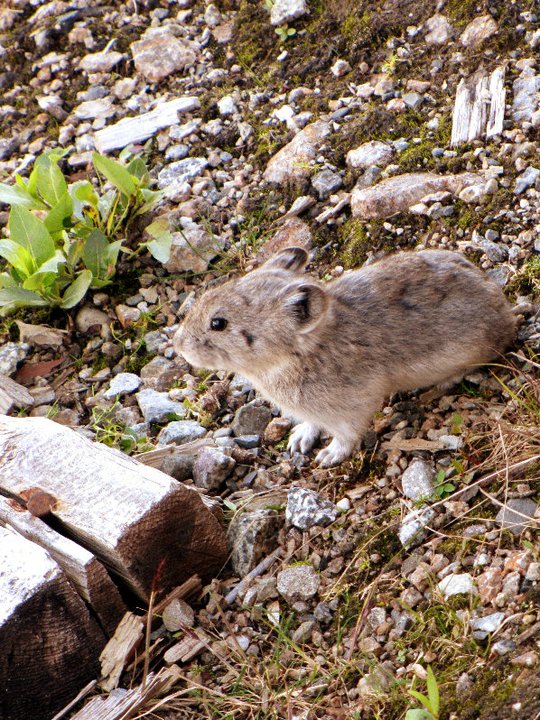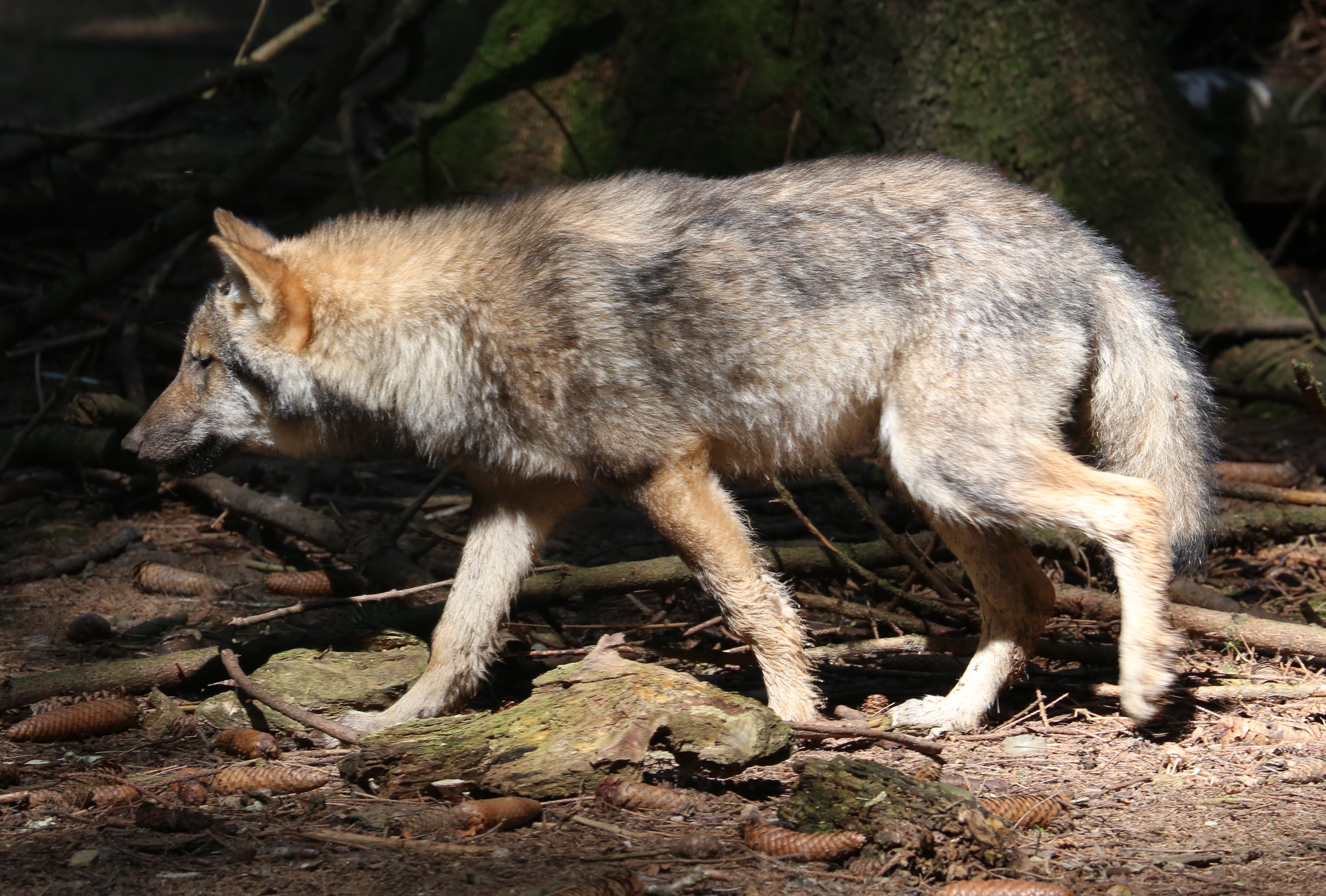|
Ili Pika
The Ili pika or magic rabbit (''Ochotona iliensis'') is a species of mammal in the family Ochotonidae, endemic to northwest China. After its discovery in 1983, it was studied for a decade. Increased temperatures, likely from global warming, and increased grazing pressure may have caused the rapid decline in population, along with air pollution. According to IUCN last assessed in 2018, the Ili pika is now considered an endangered species, with approximately fewer than 1,000 left. Description The Ili pika somewhat resembles a short-eared rabbit. It is large for a pika, with a length of and a weight of up to . It has brightly colored hair and displays large rusty-red spots on forehead, crown, and the sides of the neck. The Ili Pika resides in mountains high up, where oxygen levels are low, this helps them avoid predetors. Range It is endemic to the Tian Shan mountains of northwest Chinese province Xinjiang. A recent census indicated that the Ili pika may have been extirpated fro ... [...More Info...] [...Related Items...] OR: [Wikipedia] [Google] [Baidu] |
Mammal
A mammal () is a vertebrate animal of the Class (biology), class Mammalia (). Mammals are characterised by the presence of milk-producing mammary glands for feeding their young, a broad neocortex region of the brain, fur or hair, and three Evolution of mammalian auditory ossicles, middle ear bones. These characteristics distinguish them from reptiles and birds, from which their ancestors Genetic divergence, diverged in the Carboniferous Period over 300 million years ago. Around 6,640 Neontology#Extant taxon, extant species of mammals have been described and divided into 27 Order (biology), orders. The study of mammals is called mammalogy. The largest orders of mammals, by number of species, are the rodents, bats, and eulipotyphlans (including hedgehogs, Mole (animal), moles and shrews). The next three are the primates (including humans, monkeys and lemurs), the Artiodactyl, even-toed ungulates (including pigs, camels, and whales), and the Carnivora (including Felidae, ... [...More Info...] [...Related Items...] OR: [Wikipedia] [Google] [Baidu] |
Scree
Scree is a collection of broken rock fragments at the base of a cliff or other steep rocky mass that has accumulated through periodic rockfall. Landforms associated with these materials are often called talus deposits. The term ''scree'' is applied both to an unstable steep mountain slope composed of rock fragments and other debris, and to the mixture of rock fragments and debris itself. It is loosely synonymous with talus, material that accumulates at the base of a projecting mass of rock, or talus slope, a landform composed of talus. The term ''scree'' is sometimes used more broadly for any sheet of loose rock fragments mantling a slope, while ''talus'' is used more narrowly for material that accumulates at the base of a cliff or other rocky slope from which it has obviously eroded. Scree is formed by rockfall, which distinguishes it from colluvium. Colluvium is rock fragments or soil deposited by rainwash, sheetwash, or slow downhill creep, usually at the base of gentle ... [...More Info...] [...Related Items...] OR: [Wikipedia] [Google] [Baidu] |
Endemic Fauna Of China
Endemism is the state of a species being found only in a single defined geographic location, such as an island, state, nation, country or other defined zone; organisms that are indigenous to a place are not endemic to it if they are also found elsewhere. For example, the Cape sugarbird is found exclusively in southwestern South Africa and is therefore said to be ''endemic'' to that particular part of the world. An endemic species can also be referred to as an ''endemism'' or, in scientific literature, as an ''endemite''. Similarly, many species found in the Western ghats of India are examples of endemism. Endemism is an important concept in conservation biology for measuring biodiversity in a particular place and evaluating the risk of extinction for species. Endemism is also of interest in evolutionary biology, because it provides clues about how changes in the environment cause species to undergo range shifts (potentially expanding their range into a larger area or becomin ... [...More Info...] [...Related Items...] OR: [Wikipedia] [Google] [Baidu] |
Mammals Described In 1986
A mammal () is a vertebrate animal of the class Mammalia (). Mammals are characterised by the presence of milk-producing mammary glands for feeding their young, a broad neocortex region of the brain, fur or hair, and three middle ear bones. These characteristics distinguish them from reptiles and birds, from which their ancestors diverged in the Carboniferous Period over 300 million years ago. Around 6,640 extant species of mammals have been described and divided into 27 orders. The study of mammals is called mammalogy. The largest orders of mammals, by number of species, are the rodents, bats, and eulipotyphlans (including hedgehogs, moles and shrews). The next three are the primates (including humans, monkeys and lemurs), the even-toed ungulates (including pigs, camels, and whales), and the Carnivora (including cats, dogs, and seals). Mammals are the only living members of Synapsida; this clade, together with Sauropsida (reptiles and birds), constitutes the large ... [...More Info...] [...Related Items...] OR: [Wikipedia] [Google] [Baidu] |
Pikas
A pika ( , or ) is a small, mountain-dwelling mammal native to Asia and North America. With short limbs, a very round body, an even coat of fur, and no external tail, they resemble their close relative the rabbit, but with short, rounded ears. The large-eared pika of the Himalayas and nearby mountains lives at elevations of more than . The name ''pika'' appears to be derived from the Tungus ''pika'', and the scientific name ''Ochotona'' is derived from the Mongolian word ''ogotno, оготно'', which means pika. It is used for any member of the Ochotonidae (), a family within the order of lagomorphs, the order which also includes the Leporidae (rabbits and hares). They are the smallest animal in the lagomorph group. Only one genus, ''Ochotona'' ( or ), is extant within the family, covering 37 species, though many fossil genera are known. Another species, the Sardinian pika, belonging to the separate genus '' Prolagus'', has become extinct within the last 2,000 years owin ... [...More Info...] [...Related Items...] OR: [Wikipedia] [Google] [Baidu] |
Mammals Of China
This is a list of the mammal species recorded in China. There are 495 mammal species in China, of which thirteen are critically endangered, twenty-four are endangered, forty-seven are vulnerable, and seven are near threatened. One of the species listed for China can no longer be found in the wild. The following tags are used to highlight each species' conservation status as assessed by the International Union for Conservation of Nature: Some species were assessed using an earlier set of criteria. Species assessed using this system have the following instead of near threatened and least concern categories: Order: Sirenia (manatees and dugongs) Sirenia is an order of fully aquatic, herbivorous mammals that inhabit rivers, estuaries, coastal marine waters, swamps, and marine wetlands. All four species are endangered. *Family: Dugongidae **Genus: ''Dugong'' ***Dugong, ''D. dugon'' Order: Proboscidea (elephants) The elephants comprise three living species and are the larges ... [...More Info...] [...Related Items...] OR: [Wikipedia] [Google] [Baidu] |
List Of Endangered And Protected Species Of China
A list is a set of discrete items of information collected and set forth in some format for utility, entertainment, or other purposes. A list may be memorialized in any number of ways, including existing only in the mind of the list-maker, but lists are frequently written down on paper, or maintained electronically. Lists are "most frequently a tool", and "one does not ''read'' but only ''uses'' a list: one looks up the relevant information in it, but usually does not need to deal with it as a whole". Lucie Doležalová,The Potential and Limitations of Studying Lists, in Lucie Doležalová, ed., ''The Charm of a List: From the Sumerians to Computerised Data Processing'' (2009). Purpose It has been observed that, with a few exceptions, "the scholarship on lists remains fragmented". David Wallechinsky, a co-author of '' The Book of Lists'', described the attraction of lists as being "because we live in an era of overstimulation, especially in terms of information, and lists help ... [...More Info...] [...Related Items...] OR: [Wikipedia] [Google] [Baidu] |
Ili Prefecture
Ili Kazakh Autonomous Prefecture is an autonomous prefecture in northern Xinjiang, China. Its capital is Yining, also known as Ghulja or Kulja. Covering an area of 268,591 square kilometres (16.18 per cent of Xinjiang), Ili Prefecture shares a -long border with Kazakhstan, Mongolia, and Russia. There are nine ports of entry in Ili Prefecture at the national level, notably Khorgas. Directly administered regions () within the prefecture cover 56,622 square kilometres (21.08 per cent of Ili's total area) and have a population of 4,930,600 (63.95 per cent of Ili's registered population). Kazakhs are the second largest ethnicity in the prefecture after the Han Chinese, and make up a little over a quarter of the population. Ili is the only prefecture-level division that has other prefecture-level divisions (Altay and Tacheng Prefectures) under its administration. The term " sub-provincial autonomous prefecture" () has often been applied to Ili, but it has no legal basis under Chines ... [...More Info...] [...Related Items...] OR: [Wikipedia] [Google] [Baidu] |
Herbivore
A herbivore is an animal anatomically and physiologically evolved to feed on plants, especially upon vascular tissues such as foliage, fruits or seeds, as the main component of its diet. These more broadly also encompass animals that eat non-vascular autotrophs such as mosses, algae and lichens, but do not include those feeding on decomposed plant matters (i.e. detritivores) or macrofungi (i.e. fungivores). As a result of their plant-based diet, herbivorous animals typically have mouth structures ( jaws or mouthparts) well adapted to mechanically break down plant materials, and their digestive systems have special enzymes (e.g. amylase and cellulase) to digest polysaccharides. Grazing herbivores such as horses and cattles have wide flat- crowned teeth that are better adapted for grinding grass, tree bark and other tougher lignin-containing materials, and many of them evolved rumination or cecotropic behaviors to better extract nutrients from plants. A larg ... [...More Info...] [...Related Items...] OR: [Wikipedia] [Google] [Baidu] |
Local Extinction
Local extinction, also extirpation, is the termination of a species (or other taxon) in a chosen geographic area of study, though it still exists elsewhere. Local extinctions are contrasted with extinction, global extinctions. Local extinctions mark a change in the ecology of an area. It has sometimes been followed by a replacement of the species taken from other locations, such as with wolf reintroduction. Discussion Glacial period, Glaciation is one factor that leads to local extinction. This was the case during the Quaternary glaciation, Pleistocene glaciation event in North America. During this period, most of the native North American species of earthworm were killed in places covered by glaciation. This left them open for colonization by European earthworms brought over in soil from Europe. Species naturally become extinct from islands over time; this can be either local extinction if the species also occurs elsewhere, or in cases of endemism, island endemism, outright ex ... [...More Info...] [...Related Items...] OR: [Wikipedia] [Google] [Baidu] |
Ochotonidae
A pika ( , or ) is a small, mountain-dwelling mammal native to Asia and North America. With short limbs, a very round body, an even coat of fur, and no external tail, they resemble their close relative the rabbit, but with short, rounded ears. The large-eared pika of the Himalayas and nearby mountains lives at elevations of more than . The name ''pika'' appears to be derived from the Tungus ''pika'', and the scientific name ''Ochotona'' is derived from the Mongolian word ''ogotno, оготно'', which means pika. It is used for any member of the Ochotonidae (), a family within the order of lagomorphs, the order which also includes the Leporidae (rabbits and hares). They are the smallest animal in the lagomorph group. Only one genus, ''Ochotona'' ( or ), is extant within the family, covering 37 species, though many fossil genera are known. Another species, the Sardinian pika, belonging to the separate genus ''Prolagus'', has become extinct within the last 2,000 years owing to ... [...More Info...] [...Related Items...] OR: [Wikipedia] [Google] [Baidu] |
Xinjiang
Xinjiang,; , SASM/GNC romanization, SASM/GNC: Chinese postal romanization, previously romanized as Sinkiang, officially the Xinjiang Uygur Autonomous Region (XUAR), is an Autonomous regions of China, autonomous region of the China, People's Republic of China (PRC), located in the Northwest China, northwest of the country at the crossroads of Central Asia and East Asia. Being the List of Chinese administrative divisions by area, largest province-level division of China by area and the List of the largest country subdivisions by area, 8th-largest country subdivision in the world, Xinjiang spans over and has about 25 million inhabitants. Xinjiang Borders of China, borders the countries of Afghanistan, India, Kazakhstan, Kyrgyzstan, Mongolia, Pakistan, Russia, and Tajikistan. The rugged Karakoram, Kunlun Mountains, Kunlun and Tian Shan mountain ranges occupy much of Xinjiang's borders, as well as its western and southern regions. The Aksai Chin and Trans-Karakoram Tract regions ... [...More Info...] [...Related Items...] OR: [Wikipedia] [Google] [Baidu] |









